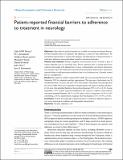| dc.contributor.author | Moura, Lidia MVR | en_US |
| dc.contributor.author | Schwamm, Eli L | en_US |
| dc.contributor.author | Moura Junior, Valdery | en_US |
| dc.contributor.author | Seitz, Michael P | en_US |
| dc.contributor.author | Hoch, Daniel B | en_US |
| dc.contributor.author | Hsu, John | en_US |
| dc.contributor.author | Schwamm, Lee H | en_US |
| dc.date.accessioned | 2016-12-02T15:24:18Z | |
| dc.date.issued | 2016 | en_US |
| dc.identifier.citation | Moura, Lidia MVR, Eli L Schwamm, Valdery Moura Junior, Michael P Seitz, Daniel B Hoch, John Hsu, and Lee H Schwamm. 2016. “Patient-reported financial barriers to adherence to treatment in neurology.” ClinicoEconomics and Outcomes Research: CEOR 8 (1): 685-694. doi:10.2147/CEOR.S119971. http://dx.doi.org/10.2147/CEOR.S119971. | en |
| dc.identifier.issn | 1178-6981 | en |
| dc.identifier.uri | http://nrs.harvard.edu/urn-3:HUL.InstRepos:29625998 | |
| dc.description.abstract | Objective: Many effective medical therapies are available for treating neurological diseases, but these therapies tend to be expensive and adherence is critical to their effectiveness. We used patient-reported data to examine the frequency and determinants of financial barriers to medication adherence among individuals treated for neurological disorders. Patients and methods Patients completed cross-sectional surveys on iPads as part of routine outpatient care in a neurology clinic. Survey responses from a 3-month period were collected and merged with administrative sources of demographic and clinical information (eg, insurance type). We explored the association between patient characteristics and patient-reported failure to refill prescription medication due to cost in the previous 12 months, termed here as “nonadherence”. Results: The population studied comprised 6075 adults who were presented between July and September 2015 for outpatient neurology appointments. The mean age of participants was 56 (standard deviation: 18) years, and 1613 (54%) were females. The patients who participated in the surveys (2992, 49%) were comparable to nonparticipants with respect to gender and ethnicity but more often identified English as their preferred language (94% vs 6%, p<0.01). Among respondents, 9.8% (n=265) reported nonadherence that varied by condition. These patients were more frequently Hispanic (16.7% vs 9.8% white, p=0.01), living alone (13.9% vs 8.9% cohabitating, p<0.01), and preferred a language other than English (15.3% vs 9.4%, p=0.02). Conclusion: Overall, the magnitude of financial barriers to medication adherence appears to vary across neurological conditions and demographic characteristics. | en |
| dc.language.iso | en_US | en |
| dc.publisher | Dove Medical Press | en |
| dc.relation.isversionof | doi:10.2147/CEOR.S119971 | en |
| dc.relation.hasversion | http://www.ncbi.nlm.nih.gov/pmc/articles/PMC5117903/pdf/ | en |
| dash.license | LAA | en_US |
| dc.subject | outcomes | en |
| dc.subject | adherence | en |
| dc.subject | cost | en |
| dc.title | Patient-reported financial barriers to adherence to treatment in neurology | en |
| dc.type | Journal Article | en_US |
| dc.description.version | Version of Record | en |
| dc.relation.journal | ClinicoEconomics and Outcomes Research: CEOR | en |
| dash.depositing.author | Hsu, John | en_US |
| dc.date.available | 2016-12-02T15:24:18Z | |
| dc.identifier.doi | 10.2147/CEOR.S119971 | * |
| dash.authorsordered | false | |
| dash.contributor.affiliated | Hsu, John | |


